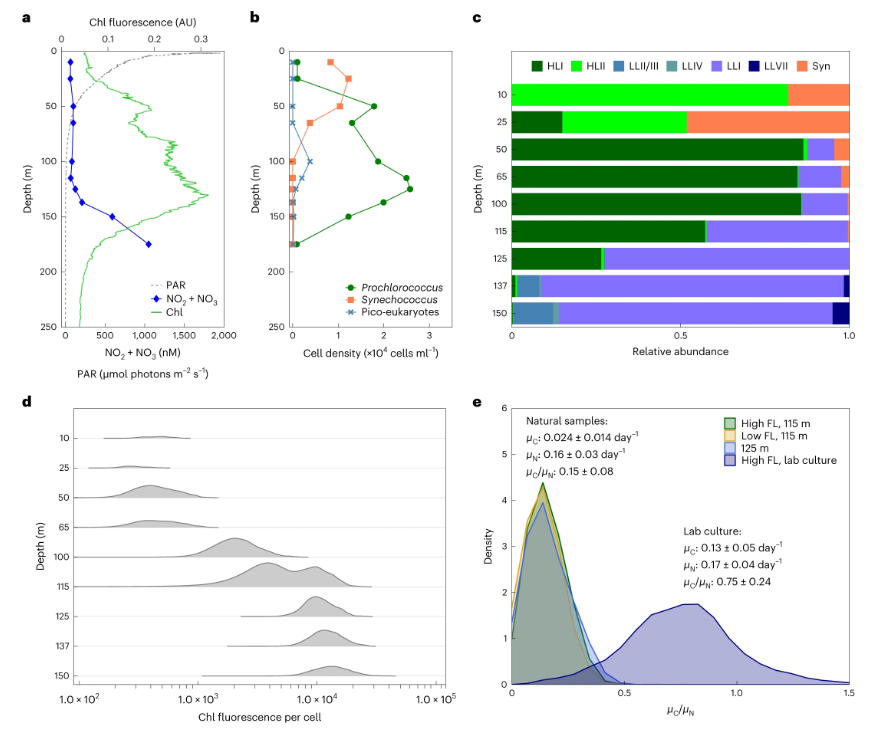单细胞测量与建模揭示原绿球藻获取大量有机碳机制
Single-Cell Measurements and Modelling Reveal Substantial Organic Carbon Acquisition by Prochlorococcus
作者: Zhen Wu, Dikla Aharonovich, Dalit Roth-Rosenberg, Osnat Weissberg, Tal Luzzatto-Knaan, Angela Vogts, Luca Zoccarato, Falk Eigemann, Hans-Peter Grossart, Maren Voss, Michael J. Follows and Daniel Sher
期刊: Nature Microbiology
Marine phytoplankton are responsible for about half of the photosynthesis on Earth. Many are mixotrophs, combining photosynthesis with heterotrophic assimilation of organic carbon, but the relative contribution of these two lifestyles is unclear. Here single-cell measurements reveal that Prochlorococcus at the base of the photic zone in the Eastern Mediterranean Sea obtain only ~20% of carbon required for growth by photosynthesis. This is supported by laboratory-calibrated calculations based on photo-physiology parameters and compared with in situ growth rates. Agent-based simulations show that mixotrophic cells could grow tens of metres deeper than obligate photo-autotrophs, deepening the nutricline by ~20 m. Time series from the North Atlantic and North Pacific indicate that, during thermal stratification, on average 8–10% of the Prochlorococcus cells live without enough light to sustain obligate photo-autotrophic populations. Together, these results suggest that mixotrophy underpins the ecological success of a large fraction of the global Prochlorococcuspopulation and its collective genetic diversity.

Fig. 3 a, Depth profiles of PAR, NO2 + NO3 and chlorophyll (Chl). b, Phytoplankton cell counts using flow cytometry. c, Relative abundance of different Prochlorococcus clades across the water column, determined by ITS sequencing (HLI denotes high-light-adapted clade I, HLII denotes high-light-adapted clade II, LLI denotes low-light-adapted clade I, LLII/III denotes low-light-adapted clades II and III, LLIV denotes low-light-adapted clade IV, LLVII denotes low-light-adapted clade VII, Syn denotes Synechococcus). d, Density plots of Prochlorococcus per-cell chlorophyll fluorescence (FL). Note the change in chlorophyll fluorescence (d) without a concomitant change in population structure (c) between 65 m and 100 m. Note also the presence of LL clades above 115 m and HL clades at 125 m (c) while a double population is observed only at 115 m (d). The circles in d represent the populations sorted and analysed by NanoSIMS, and are colour-coded as in e. e, Density plots of the ratios of C-specific C uptake rate (μC) to N-specific N uptake rate (μN) from NanoSIMS analysis of each sorted subpopulation from 115 m, the single population from 125 m, and lab cultures. The numbers of cells measured in each population are 45 (LL 115 m), 49 (HL 115 m), 55 (125 m) and 489 (lab culture).The scatter plots and gates used for these analyses are shown in Extended Data Fig. 1
海洋浮游植物贡献了地球上约一半的光合作用,其中许多是兼具光合作用自养和有机碳同化异养的混合营养型生物。但这两种营养方式的相对贡献尚不明确。研究通过单细胞测量发现,地中海东部真光层底部的原绿球藻通过光合作用获取的碳仅占生长所需总量的20%左右。通过基于光生理学参数的实验室校准计算并与原绿球藻的原位生长率进行比较证实了上述发现。基于主体的模拟表明,混合营养型生物能够生存的最大深度比专性自养生物深几十米,使得营养跃层加深约20米。北大西洋和北太平洋的时间序列表明,在热分层期间,平均8-10%的原球藻细胞在没有足够光照的情况下生存,以维持专性自养个体的生存。这些结果共同表明,混合营养是全球大部分原绿球藻取得生态成功及集体遗传多样性的基础。
(实习生江薇编译)








